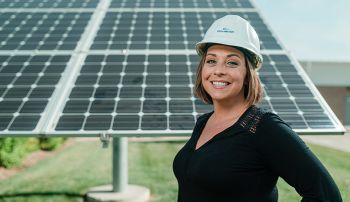Five Reasons to Explore Bifacial Solar
- June 4, 2020
- Product Promotions
- Solar Energy

Generating solar energy during a Midwest winter can be a challenge: there’s less sunlight, shorter days, and snow and cloud cover. But bifacial solar modules are set to change that (and offer a lot more, too).
These double-glass solar modules have solar cells on the front and back of each panel. The transparency offered by the double glass allows the sun to shine through, reflect off the surface beneath it, and reach solar cells on the back of the module. The result: increased solar energy collection. (A standard solar module has an EVA backsheet that captures sunlight instead of reflecting it.)
Major utilities across the United States have deployed bifacial solar technology by choice due to the financial and production benefits they’ve experienced: higher energy yield, lower total cost of ownership, and continued performance in less-than-ideal environmental conditions.
Commercial business owners can now realize these same benefits from bifacial solar. We’ve rounded up some of the most impressive advantages below.
Benefit No. 1: Longer Lifecycle
The top of each bifacial solar panel is covered in protective glass; the bottom side is covered in either glass or a clear backsheet. This makes the panels more durable than conventional solar panels.
Because sunlight flows through the module instead of being captured on the backsheet, the module also stays cooler because absorption levels are reduced. This prevents degradation and leads to a longer-lasting product over time.
Benefit No. 2: Better Winter Performance
With standard panels, having snow on the ground can be a detriment to energy production. In the Midwest, the winter months (late October through early March) are usually the least productive for solar power generation due to inclement weather and the sun’s angle.
When bifacial panels are involved, however, the snow’s reflectiveness plays well with bifacial solar modules (especially when the snow has a glaze of ice). As the sun’s rays shine through the panel, the snow acts as a reflector: It helps send the sunlight to the solar cells on the back of the module.
A white surface (like snow or a cool roof) has a higher albedo (percentage of solar radiation reflected) than a dark surface, such as grass or asphalt. This translates to better year-round energy production without a drastic drop-off in the winter.
A recent, ongoing St. Lawrence College study focused on the effects of extreme weather on photovoltaic performance also uncovered an interesting finding. The process of clearing snow is much easier on a bifacial vs. standard module for one simple reason: the increased heat generation from the albedo on the back of the module helps snow melt faster.
Benefit No. 3: Enhanced Visual Appeal
The double-glass look offers a thin profile; many also think it’s more aesthetically pleasing as compared to standard panels.
Most bifacial panels are fit with silver frames, but Van Meter has introduced a black frame for its bifacial solar modules, which provides an even sleeker look – whether they’re placed on the ground, on the roof, or somewhere else.
Benefit No. 4: Extended Warranties
As we mentioned earlier, bifacial solar panels stay cooler and don’t degrade as quickly as single panels over time. As a result, they offer a 30-year warranty instead of the 25-year warranty offered for single panels.
Benefit No. 5: Better Economics
Depending on the application, bifacial solar modules may offer a lower total cost of ownership. They provide a higher energy yield per panel and – because of that higher yield – you may need less of them to generate the power you need.
Van Meter’s Focus on Solar
Van Meter believes in bifacial solar modules so much that we plan to install them on our own facilities.
Over the years, we’ve implemented solar power at several branch locations – with very impressive results (up to 95% savings in utility bills). In the future, we plan to replace some of these installations with bifacial solar panels to create our own test bed. This will allow us to compare production levels and experiment with surfaces to evaluate reflectivity. Making an investment in bifacial solar will also help us truly understand the technology so we can offer first-hand advice as you explore it for yourself.
Van Meter stocks all the balance-of-system components you need to support solar. Our team of solar experts understands solar specification and design to help you find the best fit for your project. We also offer stress-free services to keep your solar project on track and your costs competitive.
Have questions about bifacial solar? Want to find out whether it might be a good investment for you? Send me a note – I’m happy to answer your questions!
ARTICLE BY:
CHAD WILTZ
EMPLOYEE-OWNER, ENERGY SERVICES & SOLUTIONS MANAGER
